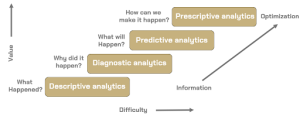In today’s data-driven world, creating impactful data products requires more than just technical expertise; it demands a deep understanding of the business landscape. Imagine trying to build a housing development without blueprints or a clear vision of the community it will serve. Similarly, developing data solutions without collaborating with key business units can result in tools that do not align with the business goals. By weaving together the insights and needs of various departments, organizations can unlock the full potential of their data, ensuring that every data product is not just functional, but transformative. In this article I will guide you through my experience as an analytics translator and the lessons I learned so far.
Working in a housing corporation, I often emphasize that success in our field depends on establishing the right groundwork, whether we’re constructing homes or building data solutions. Just as a well-built house begins with a strong foundation, the same principle applies to developing data products. Without a solid base—ensuring high-quality data and a thorough understanding of the business—a data product is unlikely to fulfill its purpose effectively.
Understanding and identifying business challenges
When starting at a new organization, it’s crucial to first get a feel for the organization’s goals, strategies, and challenges. Start by identifying the different business units, the decision-makers within these units, and their key stakeholders. Develop a clear understanding of the business processes and data flows, pinpointing any bottlenecks, pain points, or opportunities for improvement. This comprehensive approach ensures that the data product aligns with the organization’s needs and maximizes its potential value.
After the first round of investigation, you can gain a clear understanding of the organizational needs and the key challenges they face. According to the golden circle principle (Simon Sinek) you now know the “why” of why you are developing a data product. To determine the right solution for this business need, it is essential to deepen your understanding of the organization’s data and IT landscape. With these insights, you can define which data product will best fit the organization and address the ‘why’ that was identified. For me, the first step is always to assess the data maturity within the organization or the specific department you’re working with.This foundational understanding ensures that the solutions you propose are not only relevant but also strategically aligned with the organization’s goals.

1. Descriptive analytics
To determine the data maturity of an organization I use the Gartner model which entails four levels: descriptive analytics, diagnostic analytics, predictive analytics and prescriptive analytics. To start with the first level, descriptive analytics, which is the foundational level, where data is used to describe what has happened in the past. It focuses on historical data, helping organizations understand trends and patterns. So, back to the example of the housing corporation. The first thing that caught my attention when I started there was the amount of time and effort they were investing in spreadsheets. All their data insights and analysis were based on static exports from source systems, which were then manually compiled into one massive spreadsheet. Which results in three issues:
- Firstly, manually processing data is not only time-consuming but also detracts from the core responsibilities of a real estate advisor.
- Secondly, the manual handling of data increases the risk of errors, both in the data itself and in the application of business rules.
- Lastly, relying on static data can be problematic, as it does not account for changes over time; accurate insights require access to up-to-date information.
Meanwhile, a cloud-based data lake was already available for storing and processing this information, with the capability to visualize the necessary insights in (near) real-time. Recognizing this gap, my initial focus was on automating their current data and information flows. By moving away from manually generated spreadsheet insights and leveraging the existing data infrastructure, we could free up significant time for the team. This shift allowed them to focus on their core tasks. The ultimate goal was to enable the organization to have a better grasp of their portfolio and make strategic decisions about maintenance and investments planning based on accurate, (near) real-time data insights. This transformation not only streamlined their processes but also laid the foundation for more advanced analytics capabilities.
2. Diagnostic analytics
In the second level of Gartner’s data maturity theory, Diagnostic Analytics, organizations move beyond describing past events to understanding why they happened. This involves identifying causes and correlations, often using more advanced data analysis techniques. After the data foundation was established, with all relevant data extracted and stored in a centralized data lake, another significant problem was addressed as well. Previously, with different departments generating various exports from source systems at different times, it was challenging to determine which version of the spreadsheet held the most accurate information. This fragmented approach often led to inconsistencies and confusion. However, by centralizing all data within a single data lake, the organization could finally achieve the principle of a single source of truth.This not only ensured that everyone was working with the same accurate data but also laid the groundwork for more consistent, reliable decision-making across the organization. With input from subject matter experts, the data can then be elevated to unlock its full potential. For example, within the housing corporation, it was a significant challenge to obtain a comprehensive overview of all maintenance activities, investment projects, and sustainability improvements across the portfolio. This difficulty was compounded by the fact that several departments were involved in decision-making, each using different systems to register the data. By integrating data from multiple sources and leveraging advanced analytical tools within the data lake, the organization can now derive deeper insights. This integration not only enhances decision-making but also fosters a more data-driven culture, where strategic choices are informed by comprehensive and near real-time data analysis.
3. Predictive analytics
Predictive Analytics leverages historical data and statistical models to anticipate future outcomes. Predictive analytics plays a crucial role in forecasting trends and identifying potential risks and opportunities. Achieving this level of data maturity requires a solid data foundation, as accurate input is essential for building reliable predictive models. Additionally, it is important to consider whether reaching this advanced level of data maturity is truly necessary, or if the current insights provided by your data are already sufficient.
At the housing corporation, we are still focusing on establishing the foundations and generating insights to support informed decision-making. The organization’s portfolio includes a diverse range of units, each with its own unique characteristics—such as target demographics, neighborhood contexts, and building structures. This diversity makes it challenging to apply a uniform policy across the portfolio, for example when it comes to predicting maintenance needs, as each unit requires tailored approaches based on its specific circumstances.
4. Prescriptive analytics
The highest level of data maturity involves not only predicting future outcomes but also recommending actions to achieve desired results. At this stage, prescriptive analytics provides guidance on the next steps, often utilizing optimization and simulation techniques. However, reaching this level is both challenging and often not desirable for many organizations. For instance, in the case of the housing corporation, predictive analytics alone is currently not feasible due to the complexity and specificity of the portfolio’s needs. Adding prescriptive analytics to these predictive models would introduce even greater complexity and likely lead to inaccuracies. Creating a good living environment that addresses the diverse needs and desires of residents requires specific expert knowledge, which cannot simply be encapsulated in a data model.

Conclusion
To sum up the lessons learned, technical expertise alone isn’t enough—having a deep business understanding is just as crucial for the success of a data product. Additionally, determining the maturity level of your data analytics and setting a target for where you want to go will help define the right scope for the data product you’re developing. However, this doesn’t mean the goal will remain fixed over the years. The data-driven world is constantly evolving, presenting new opportunities, and organizations must keep pace with these changes to stay competitive. Always ask yourself why you’re doing what you’re doing and what you aim to achieve. If you are unsure where to start or how to reach your goals, do not hesitate to reach out—I would love to help you navigate this journey together! You can reach out to me at lotte@aurai.com.
